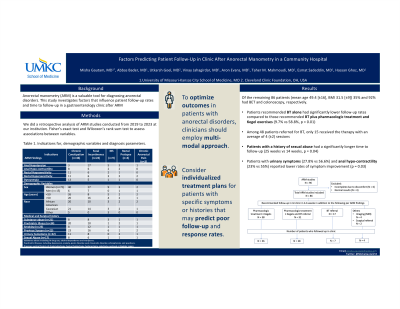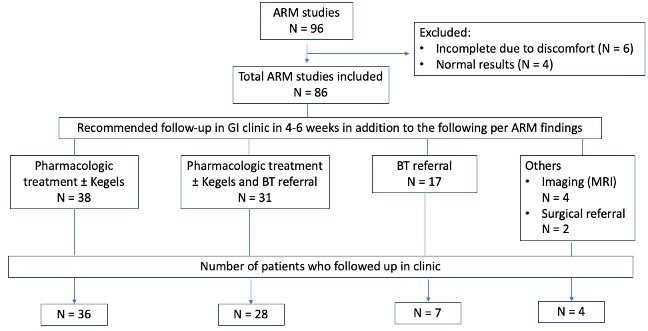Tuesday Poster Session
Category: Functional Bowel Disease
P4057 - Factors Predicting Patient Follow-Up in Clinic After Anorectal Manometry in a Community Hospital
Tuesday, October 29, 2024
10:30 AM - 4:00 PM ET
Location: Exhibit Hall E

Has Audio

Misha Gautam, MD
University of Missouri - Kansas City School of Medicine
Kansas City, MO
Presenting Author(s)
Misha Gautam, MD1, Abbas Bader, MD1, Utkarsh Goel, MD2, Vinay Jahagirdar, MD1, Evans Aron, MD1, Tahar M. Mahmoudi, MD1, Esmat Sadeddin, MD1, Hassan Ghoz, MD1
1University of Missouri - Kansas City School of Medicine, Kansas City, MO; 2Cleveland Clinic Foundation, Cleveland, OH
Introduction: Anorectal manometry (ARM) with balloon expulsion test (BET) is a comprehensive tool in diagnosing anorectal sensorimotor disorders and biofeedback therapy (BT) is an evidence-based treatment for them. However, their utility is often hindered by logistic barriers like lack of patient follow-up in clinic thereafter. In this study, we sought to assess the factors that predict patient follow-up in Gastroenterology clinic after ARM and the time to follow-up visit.
Methods: We did a retrospective analysis of ARM studies conducted at our institution, between 2019 to 2023, for the association of variables of interest (i.e., demographic variables, indications for ARM, patient insurance, ARM findings and treatments recommended) with the outcome measures (i.e., patient follow-up rates in clinic after ARM and the time to follow-up visit). Fisher’s exact test and Wilcoxon’s rank sum test were used to compare associations of predictors and outcomes.
Results: A total of 96 patients had ARM during the study period. Of these, 6 could not complete the study due to discomfort and 4 had normal results. For the remaining study cohort of 86 patients, BET was not done in 56 patients (65%), prior to the study colonoscopy was done for 79 (92%) patients, the mean age and BMI were 49.4 years ([SD] ±16) and 31.5 (±9) respectively. Indications for the studies have been summarized in Table1. Based on ARM findings, patients who were recommended BT alone had significantly lower rates of follow-up in clinic compared to those who were recommended pharmacologic treatment and Kegel exercises in addition to BT (58.8% vs 9.7%, p< 0.01) (Figure1). Of 48 patients that were referred to BT, only 15 patients received BT with an average of 4 (±2) sessions. Patients with history of sexual abuse had significantly longer duration to first follow-up (14 weeks vs 25 weeks, p=0.04). Additionally, those with co-existing urinary symptoms (27.8% vs 56.6%) and anal hypo-contractility (23% vs 55%) reported subjective symptom improvement less frequently when compared to the others (p=0.03). There were no other significant differences among other variables of interest in regard to outcome measures.
Discussion: Multi-faceted approach to treatment with medical management, behavioral modification and BT ensures better response and higher follow-up rates among patients undergoing ARM. Specific symptoms and history of sexual abuse can be predictors for negative outcomes/follow-up rates and can benefit from an individualized approach to treatment.

Note: The table for this abstract can be viewed in the ePoster Gallery section of the ACG 2024 ePoster Site or in The American Journal of Gastroenterology's abstract supplement issue, both of which will be available starting October 27, 2024.
Disclosures:
Misha Gautam, MD1, Abbas Bader, MD1, Utkarsh Goel, MD2, Vinay Jahagirdar, MD1, Evans Aron, MD1, Tahar M. Mahmoudi, MD1, Esmat Sadeddin, MD1, Hassan Ghoz, MD1. P4057 - Factors Predicting Patient Follow-Up in Clinic After Anorectal Manometry in a Community Hospital, ACG 2024 Annual Scientific Meeting Abstracts. Philadelphia, PA: American College of Gastroenterology.
1University of Missouri - Kansas City School of Medicine, Kansas City, MO; 2Cleveland Clinic Foundation, Cleveland, OH
Introduction: Anorectal manometry (ARM) with balloon expulsion test (BET) is a comprehensive tool in diagnosing anorectal sensorimotor disorders and biofeedback therapy (BT) is an evidence-based treatment for them. However, their utility is often hindered by logistic barriers like lack of patient follow-up in clinic thereafter. In this study, we sought to assess the factors that predict patient follow-up in Gastroenterology clinic after ARM and the time to follow-up visit.
Methods: We did a retrospective analysis of ARM studies conducted at our institution, between 2019 to 2023, for the association of variables of interest (i.e., demographic variables, indications for ARM, patient insurance, ARM findings and treatments recommended) with the outcome measures (i.e., patient follow-up rates in clinic after ARM and the time to follow-up visit). Fisher’s exact test and Wilcoxon’s rank sum test were used to compare associations of predictors and outcomes.
Results: A total of 96 patients had ARM during the study period. Of these, 6 could not complete the study due to discomfort and 4 had normal results. For the remaining study cohort of 86 patients, BET was not done in 56 patients (65%), prior to the study colonoscopy was done for 79 (92%) patients, the mean age and BMI were 49.4 years ([SD] ±16) and 31.5 (±9) respectively. Indications for the studies have been summarized in Table1. Based on ARM findings, patients who were recommended BT alone had significantly lower rates of follow-up in clinic compared to those who were recommended pharmacologic treatment and Kegel exercises in addition to BT (58.8% vs 9.7%, p< 0.01) (Figure1). Of 48 patients that were referred to BT, only 15 patients received BT with an average of 4 (±2) sessions. Patients with history of sexual abuse had significantly longer duration to first follow-up (14 weeks vs 25 weeks, p=0.04). Additionally, those with co-existing urinary symptoms (27.8% vs 56.6%) and anal hypo-contractility (23% vs 55%) reported subjective symptom improvement less frequently when compared to the others (p=0.03). There were no other significant differences among other variables of interest in regard to outcome measures.
Discussion: Multi-faceted approach to treatment with medical management, behavioral modification and BT ensures better response and higher follow-up rates among patients undergoing ARM. Specific symptoms and history of sexual abuse can be predictors for negative outcomes/follow-up rates and can benefit from an individualized approach to treatment.

Figure: Flow diagram depicting follow-up of patients after initial ARM study
Note: The table for this abstract can be viewed in the ePoster Gallery section of the ACG 2024 ePoster Site or in The American Journal of Gastroenterology's abstract supplement issue, both of which will be available starting October 27, 2024.
Disclosures:
Misha Gautam indicated no relevant financial relationships.
Abbas Bader indicated no relevant financial relationships.
Utkarsh Goel indicated no relevant financial relationships.
Vinay Jahagirdar indicated no relevant financial relationships.
Evans Aron indicated no relevant financial relationships.
Tahar Mahmoudi indicated no relevant financial relationships.
Esmat Sadeddin indicated no relevant financial relationships.
Hassan Ghoz indicated no relevant financial relationships.
Misha Gautam, MD1, Abbas Bader, MD1, Utkarsh Goel, MD2, Vinay Jahagirdar, MD1, Evans Aron, MD1, Tahar M. Mahmoudi, MD1, Esmat Sadeddin, MD1, Hassan Ghoz, MD1. P4057 - Factors Predicting Patient Follow-Up in Clinic After Anorectal Manometry in a Community Hospital, ACG 2024 Annual Scientific Meeting Abstracts. Philadelphia, PA: American College of Gastroenterology.

